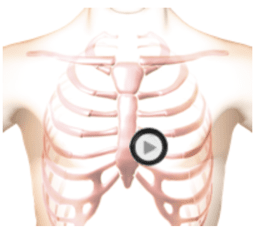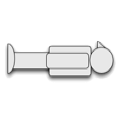Ebstein's Anomaly - C30 Auscultation Lesson with Recordings
Virtual Auscultation


The patient's position is supine.
Lesson
This is an example of Ebstein's Anomaly as heard at the tricuspid area. The first heart sound is increased due to thickening of the tricuspid valve leaflets. The second heart sound is normal. A rectangular murmur of tricuspid regurgitation fills all of systole. An opening snap occurs 100 milliseconds into diastole followed by a decrescendo-crescendo murmur of mitral stenosis. These findings are all a manifestation of downward displacement of the tricuspid valve into the right ventricle In the anatomy video you can see the enlarged right atrium and the small right ventricle. The upward plume from the right ventricle to the right atrium represents the systolic murmur. The downward plume from the right atrium to the right ventricle represents the diastolic murmur. This abnormality is congenital in nature.Waveform
Heart Sounds Video
Review the cardiac animation. Notice the enlarged right atrium and the small right ventricle. The upward plume from the right ventricle to the right atrium represents the systolic murmur.
The downward plume from the right atrium to the right ventricle represents the diastolic murmur.
Authors and Sources
Authors and Reviewers
-
Heart sounds by Dr. Jonathan Keroes, MD and David Lieberman, Developer, Virtual Cardiac Patient.
- Lung sounds by Diane Wrigley, PA
- Respiratory cases: William French
-
David Lieberman, Audio Engineering
-
Heart sounds mentorship by W. Proctor Harvey, MD
- Special thanks for the medical mentorship of Dr. Raymond Murphy
- Reviewed by Dr. Barbara Erickson, PhD, RN, CCRN.
-
Last Update: 12/11/2022
Sources
-
Heart and Lung Sounds Reference Library
Diane S. Wrigley
Publisher: PESI -
Impact Patient Care: Key Physical Assessment Strategies and the Underlying Pathophysiology
Diane S Wrigley & Rosale Lobo - Practical Clinical Skills: Lung Sounds
- Essential Lung Sounds
Diane S. Wrigley, PA-C
Published by MedEdu LLC - PESI Faculty - Diane S Wrigley
-
Case Profiles in Respiratory Care 3rd Ed, 2019
William A.French
Published by Delmar Cengage - Essential Lung Sounds
by William A. French
Published by Cengage Learning, 2011 - Understanding Lung Sounds
Steven Lehrer, MD
- Clinical Heart Disease
W Proctor Harvey, MD
Clinical Heart Disease
Laennec Publishing; 1st edition (January 1, 2009)